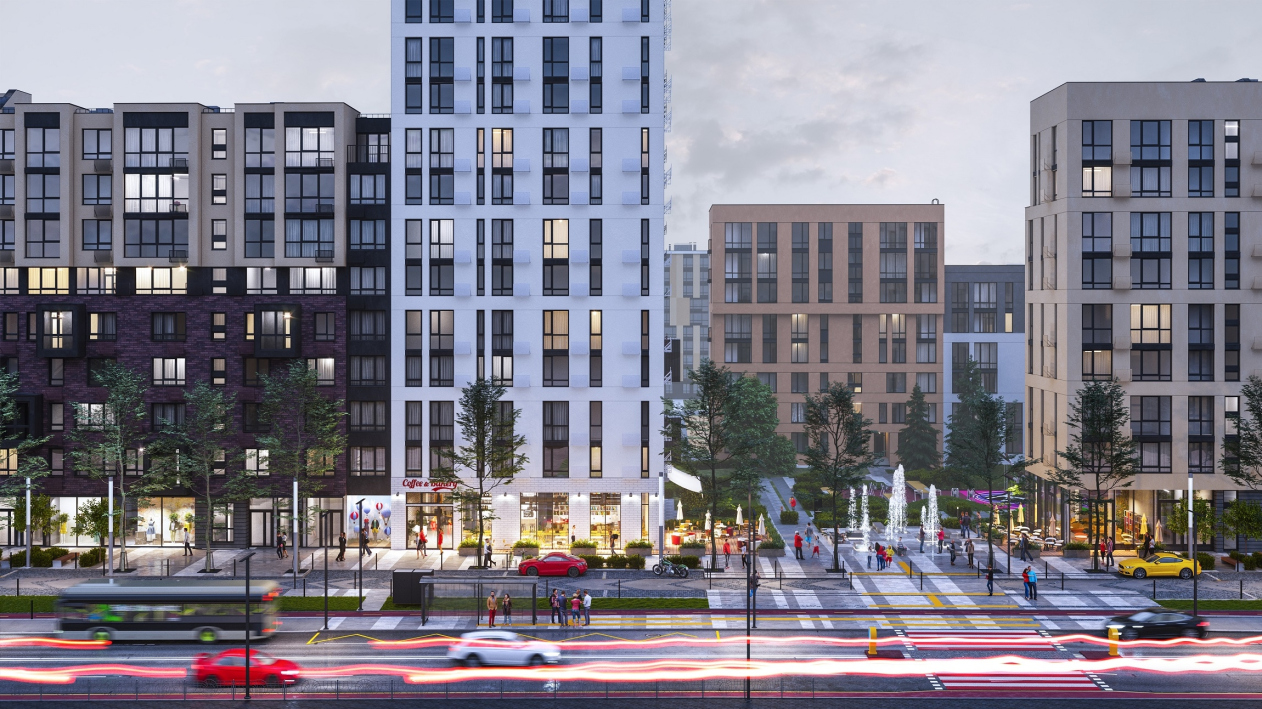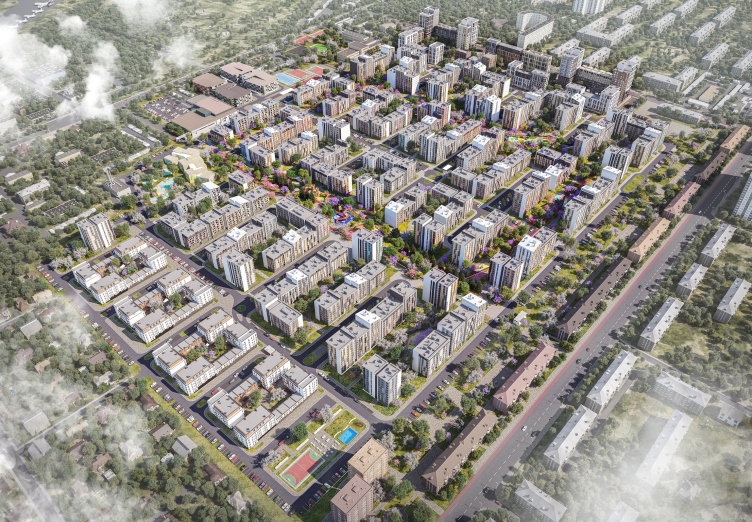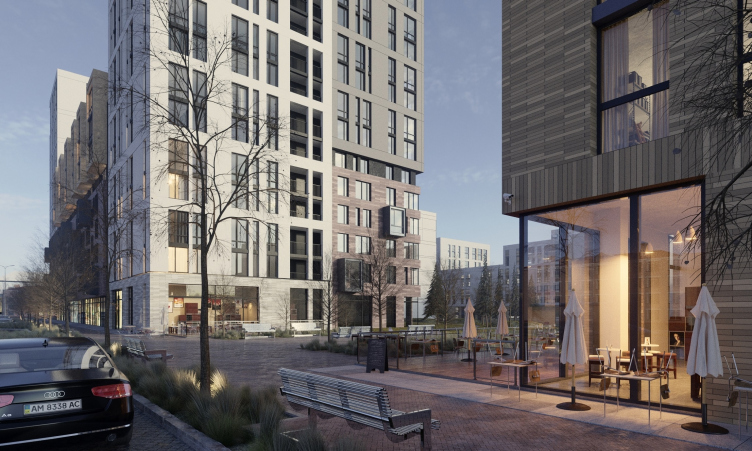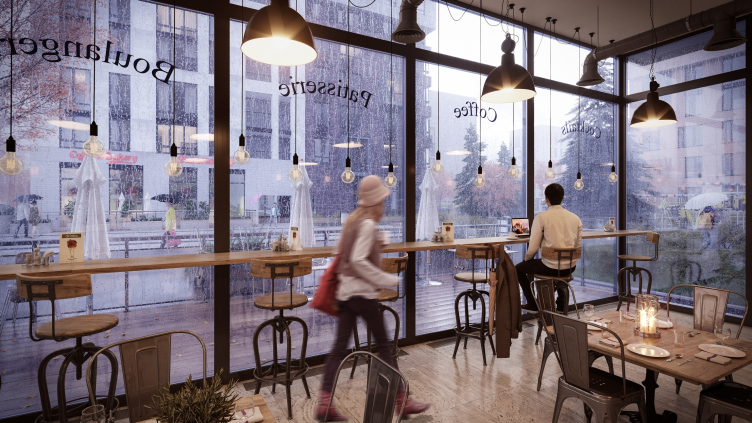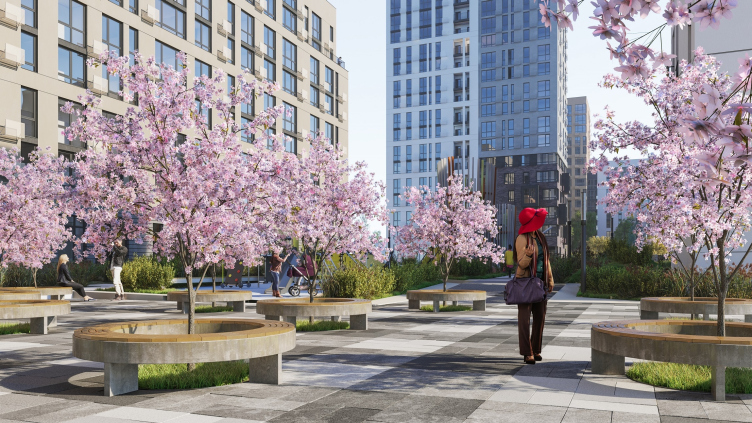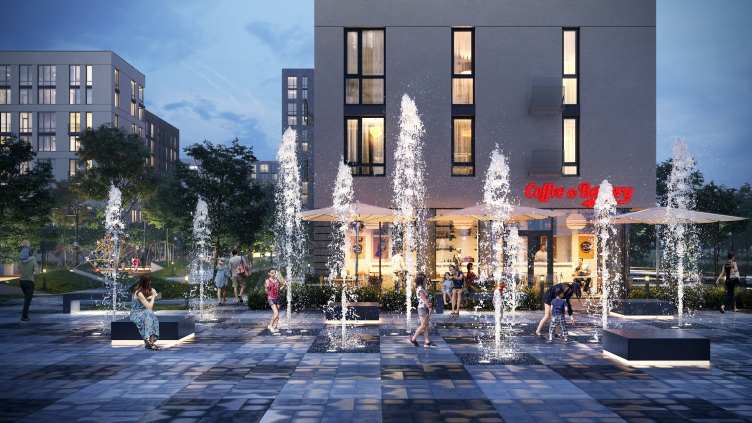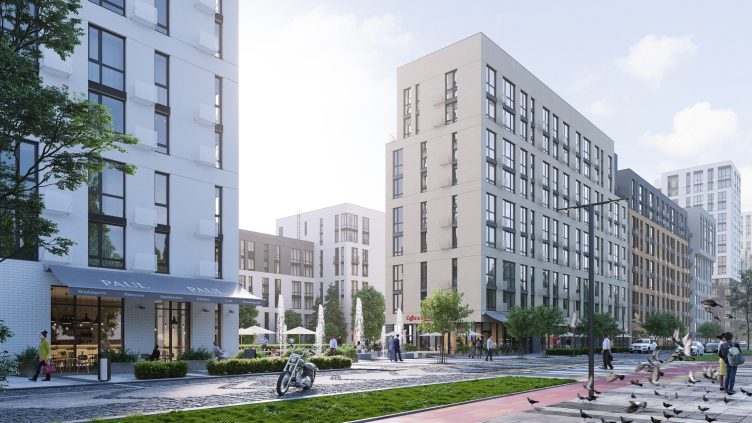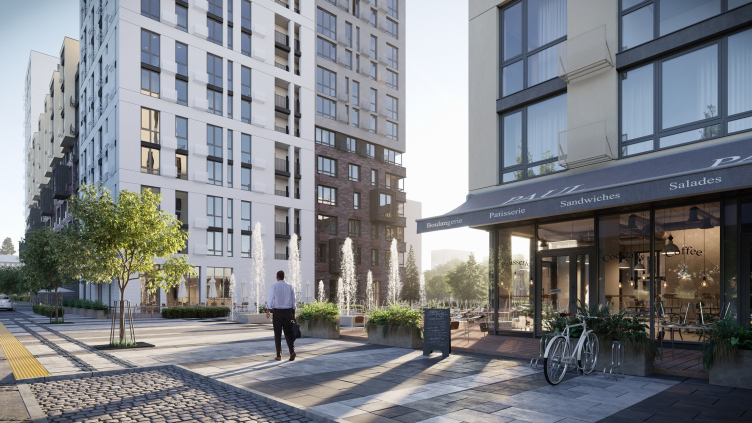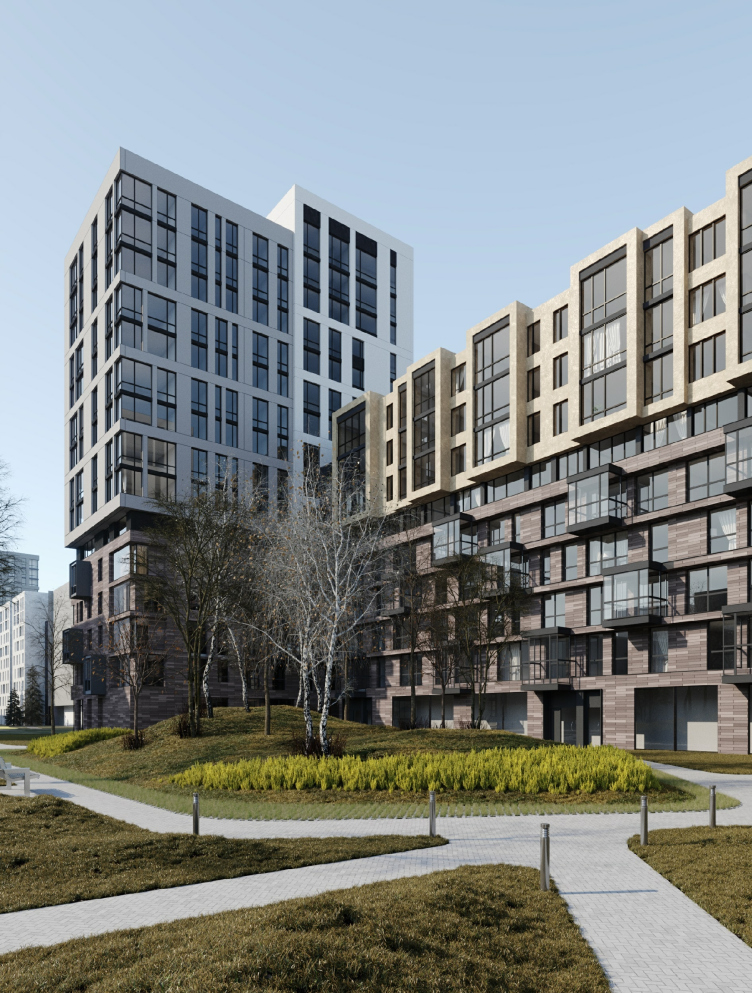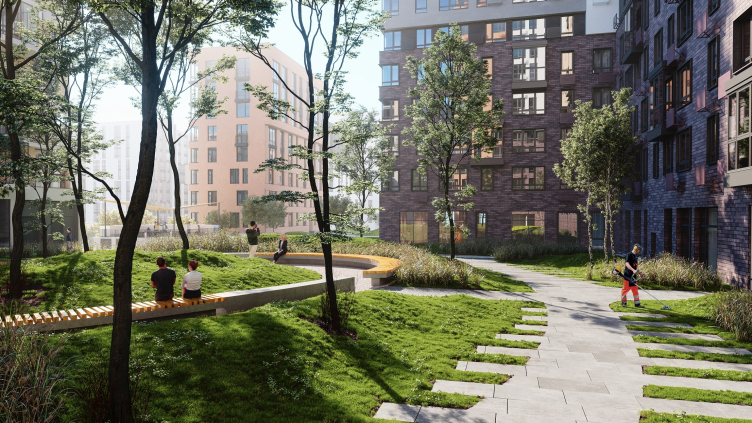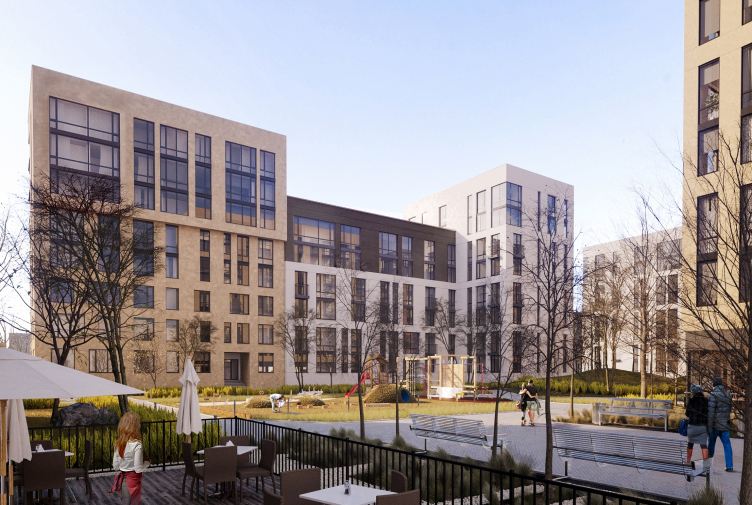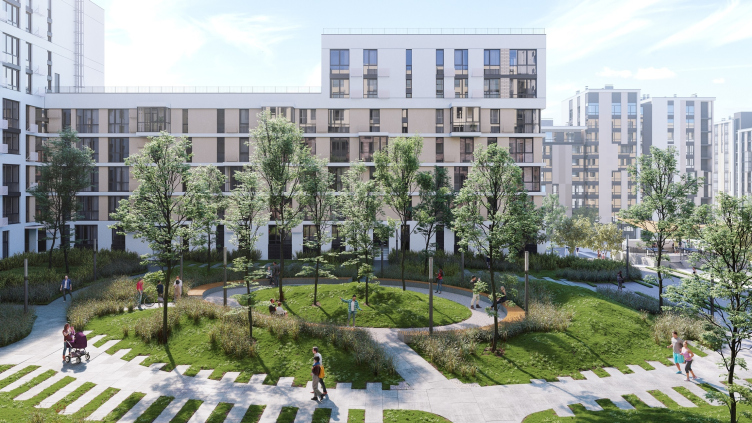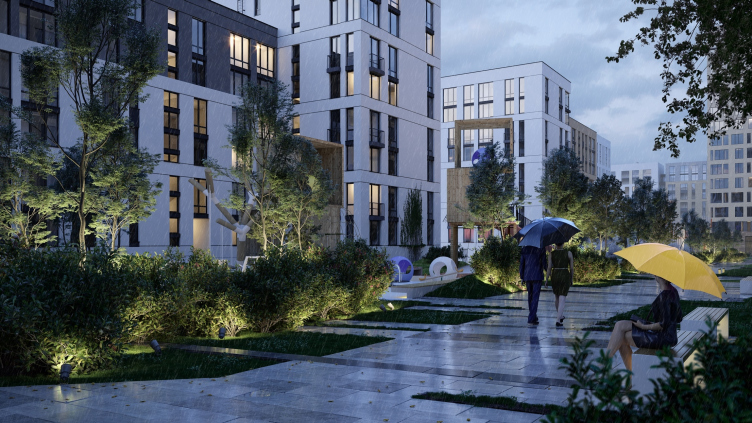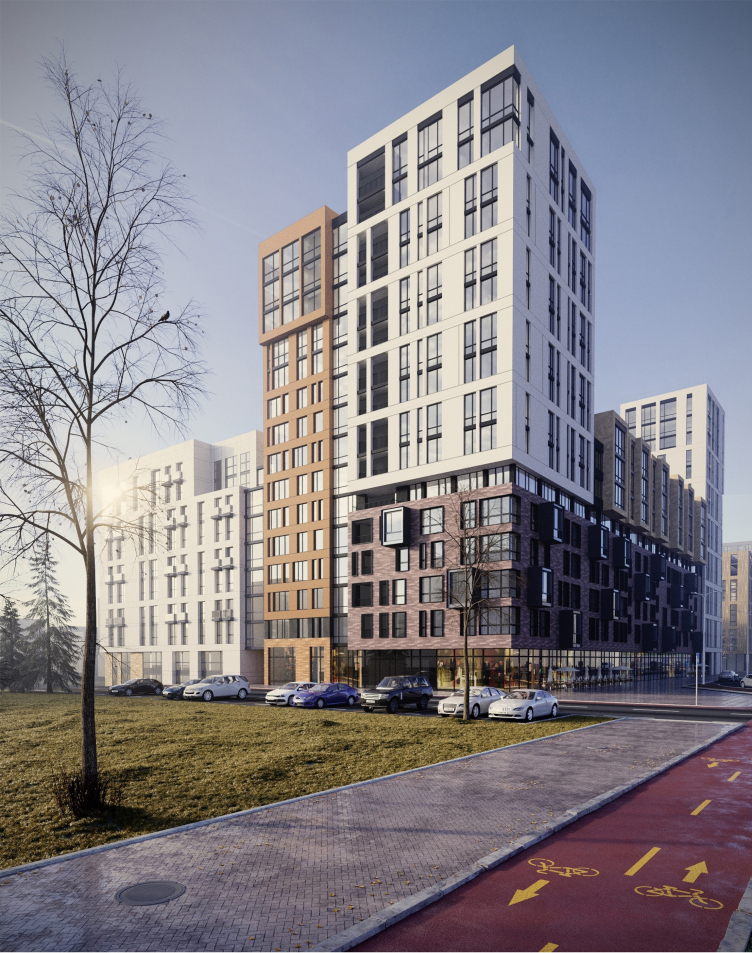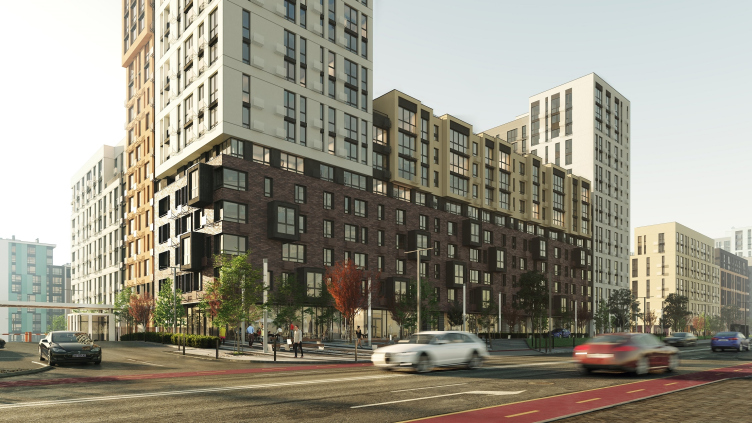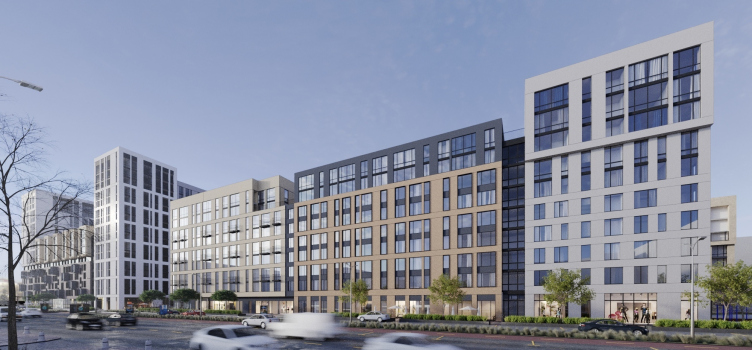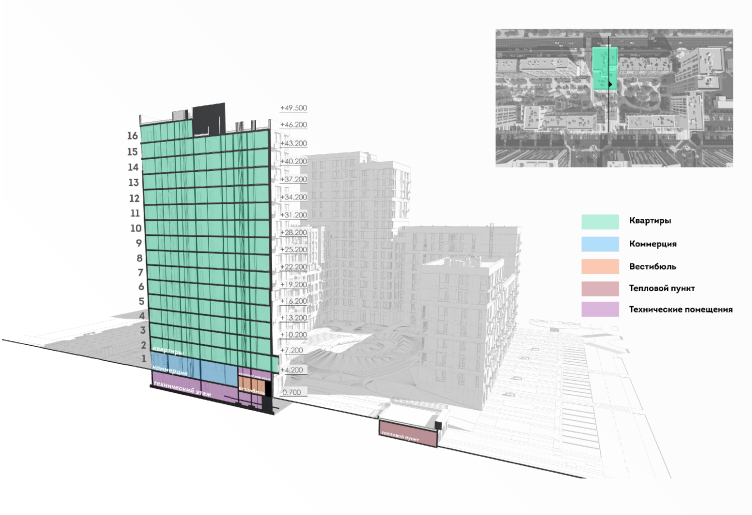The territory of the future “Fayna Town” housing complex is located at the west suburb of Kiev, in the district of Nivki, situated between a string of parks in the valley of the Syrets River and the territory of the Antonov Aviation Technological Complex. The five-story houses that were built here in the 1960’s are now overgrown with trees; there are also large surviving clusters of low-rise privately owned cottages, and the “Cherry Garden” park nearby – the choice of the location for the new housing complex is quite successful. The transportation accessibility is ensured by the “Nivki” metro station, which is about a 15-minutes’ walk away, and the Brest-Litovskoe Highway, along the length of which, as a matter of fact, the metro line goes, and which at this particular segment is called “Prospect Pobedy” (“Victory Avenue”).
The housing complex is going to be a large one – it must cover the territory of about 40 hectares, which is currently occupied by vegetable gardens and greenhouses of the Selkhozpoligon (which literally translates as “agricultural testing ground”) and the buildings of Kiev’s Expoplaza, which will also be replaced by the housing complex. It is here, in the north part of the territory stretching along the Salutnaya Street, that the construction of the first stage will take place, which will also include the tallest buildings of the complex ranging from 9 to 19 stories high.
Generally, however, the complex only slightly “outgrows” its five-story surroundings. From north to south, the number of floors gradually decreases, first to 6-9, and then to 4-5 in the last south side stage of construction bordering on the private cottages area. The low-rise quality of the housing complex is something that the architects deservedly take pride in: in this day and age of soaring new houses, especially in metropolitan cities (and Kiev can be definitely described as one), the authors of the project were able to convince the developer in the correctitude of their approach, which not only yields crazy amounts of square meters but also forms a comfortable city environment that become one of the competitive edges of the complex. As for the client, KAN Development, it is not the first time that ARKHIMATIKA works with this company: they have already built a housing complex named “Comfort Town”, whose bright façades and silhouettes of pitched roofs livened up the context of the left bank of the Dnipro River. This complex was not of the high-rise type either – from 2 to 14 floors.
The houses inside the complex follow the principle of modern city block planning: the sections are grouped together around vehicle-free yards, the driveways are situated in between the blocks, and these driveways have spots of overland parking lots strung on them (there are no underground parking garages but the architects have designed two multilevel overland ones closer to the Tupoleva Street in the western part of the complex). However, in full accordance with the principle practiced by ARKHIMATIKA, the city blocks are not closed – they are “half-open”. This allows the architects to make the most of the benefits of the city block planning (first of all, the private yards), and avoid its drawbacks, namely, the excessive closeness, the “well” yard effect, and too much shade. For this reason, the city blocks are opened up southward. In some places, however, they form a snaky zigzag, and a slab appears between two frames.
"Fayna Town" housing complex. First stage of construction © ARKHIMATIKA
“Fayna Town” housing complex
Copyright: © Archimatika
Just as diverse are the buildings’ silhouettes: at the corners of the blocks, the buildings are 2 or 3 stories higher, and, in addition, oftentimes one section inside the “link” also slightly rises, in this case, livening up the composition with a single-side roof pitch. “This technique is very convenient for getting a maximum number of corner apartments, the most advantageous and popular layout option – the architects explain – A regular city block has only four corners in it, but this way we were able to get a yield of 16-20 corner apartments from each block”.
The layouts of the apartments in this housing complex are a separate subject that is worth mentioning. The five houses of the first construction stage are already offering 40 layout configurations – from single-room apartments and studios to 3-room and two-story apartments. As we already shared, ARKHIMATIKA came up its own efficient approach to designing the apartment floor plans, calling it “PRO” – it ensures that not a single square meter goes to waste, the architects claim. And, while TIME housing complex had about 97%, of such apartments, Fayna Town has a full 100%.
Back to the layout of the complex, though! The architects “opened up” the otherwise closed city blocks for a purpose: their vehicle-free yards are united in a single pedestrian network, which, in turn, forms what you might call a “distributed park”. Walking around, one will be able to easily get from one yard to another; this way the residents will be guaranteed a variety of impressions and acquaintances instead of living in a closed private little world. Frankly speaking, this advantage was brought over into the city block planning from the Soviet “micro-district” type – and the architects ultimately came up with the right hybrid idea.
When still in the stage of a pre-project survey, the authors discovered a string of 50-year-old fir trees in the middle of the land site, and decided to keep the trees intact. This alley will become a promenade and a crosswise pedestrian axis. The promenade will also have a 3-km bicycle trail running in the middle of it; it will become the axis of the pedestrian promenade and provide the connection between most of the pedestrian zones turning them into a huge single promenade. “At some places it will be narrow, and at some places wide – the architects share – and at two points it will pass over a driveway like a bicycle and pedestrian bridge”.
"Fayna Town" housing complex. First stage of construction © ARKHIMATIKA
The authors also designed a highly sophisticated infrastructure: two private kindergartens and an elementary school, a supermarket, a fitness center, sports fields, recreation areas, and, curiously enough, two barbecue spots (which is not to be encountered in any new housing complex in Kiev). Due to the fact that the territory will be a public place, the infrastructure will also be used by the residents of the surrounding houses, which, in turn, will increase the client base of the local businesses operating on the territory of Comfort Town.
Landscaping plan. "Fayna Town" housing complex. First stage of construction © ARKHIMATIKA
The buildings belonging to the first construction stage (which will be built already in 2018), as we remember, will be built in the place of the former Expoplaza hangars, alongside the Salutnaya Street, three houses in the eastern part being built first. This is the only border of the complex that runs alongside a busy highway with a bus route, and because of that the architects’ task was to develop its strong points as a city street – as opposed to the “quiet and homely” area inside. Here the buildings are larger, and the height difference is greater – from 16 to 9 floors.
“What we did was we looked at the Kreshchatik Street, measured its pedestrian part and found out that its length was about 450 meters, almost the same as the length of our street section – Dmitry Vasilyev explains – And we decided to turn our fragment of the Salutnaya Street into a promenade, with a dense array of cafes and shops. The city environment will be quite different here – busy and bustling”. For this, all the first floors of the street are turned into shop windows, and the premises are reserved for commercial leasing.
"Fayna Town" housing complex. First stage of construction © ARKHIMATIKA
"Fayna Town" housing complex. First stage of construction © ARKHIMATIKA
"Fayna Town" housing complex. First stage of construction © ARKHIMATIKA
"Fayna Town" housing complex. First stage of construction © ARKHIMATIKA
Copyright: © Archimatika
"Fayna Town" housing complex. First stage of construction © ARKHIMATIKA
The authors provided for the territory organization as well: trees, benches, fashionable filed herbs in the flowerbeds; between the houses there are summer terraces of the cafes. This is not just territory organization but, just as was the case with the apartment plans, it is the PRO version of it: it rests on the concept of a smart street which was proposed by the creative partner of ARKHIMATIKA Andrey Brazhnik from the company “Kulman-Workshop”, a “smart” kind of city environment that reacts to the presence of people – for example, making the street lights brighter when there are many people around and dimming it in order to save the power when there is nobody there. This concept also includes modern services, such as the opportunity to charge your smartphone while sitting on a bench or electric cars charging stations. These, by the way, are designed not only on the city street but also on the promenade.
"Fayna Town" housing complex. First stage of construction © ARKHIMATIKA
"Fayna Town" housing complex. First stage of construction © ARKHIMATIKA
"Fayna Town" housing complex. First stage of construction © ARKHIMATIKA
The yards of the houses of the first construction stage also have a lot of thought-out details about them: geo plastics, trees, galleries on the first floors and private terraces for their residents.
"Fayna Town" housing complex. First stage of construction © ARKHIMATIKA
"Fayna Town" housing complex. First stage of construction © ARKHIMATIKA
"Fayna Town" housing complex. First stage of construction © ARKHIMATIKA
"Fayna Town" housing complex. First stage of construction © ARKHIMATIKA
"Fayna Town" housing complex. First stage of construction © ARKHIMATIKA
Copyright: © Archimatika
"Fayna Town" housing complex. First stage of construction © ARKHIMATIKA
The façades of the first stage, just as all their successors, for that matter, are all subjugated to the theme of pristine modernism of vertical proportions. But then again, the plastic diversity is interesting to the architects just as much, especially in the case with two “accent” houses at the northeast and northwest corners which play the role of the “visiting cards” of the complex; one of them overlooks the city standing almost next to the crossroads, the other faces the Aviation Technological Complex but it complements the first one.
The towers are light-colored, almost white. Between them stretches a horizontal block of dark cherry colored brick, its scale and proportions being approximately like those of a five-story building. In terms of plastique, however, it is a bright colorful accent, I would say, in the spirit of MVRDV experiments. Higher up, there is a glass stripe, and there is yet another horizontal above it – a beige one consisting of shallow but still noticeable “television-shaped” projections.
"Fayna Town" housing complex. First stage of construction © ARKHIMATIKA
"Fayna Town" housing complex. First stage of construction © ARKHIMATIKA
"Fayna Town" housing complex. First stage of construction © ARKHIMATIKA
This is the most plastique and the most accentuated part of complex. As we move deeper into the complex, the design solutions become more reserved and not as textured, although the depth of the façades, the diversity of color, and the visual fracturing of the houses, resonant with the structure of the street of the XIX century, “when the estate properties were small” is kept throughout the project as the guiding principle. The color in this case is respectable to the point of conservative, unlike the rainbow-like Comfort Town: the color range includes beige, white, light-gray, brown, and mahogany.
"Fayna Town" housing complex. First stage of construction © ARKHIMATIKA
"Fayna Town" housing complex. First stage of construction © ARKHIMATIKA
“We are looking to create a comfortable architectural environment for everybody, including children and the elderly, pedestrians, cyclists, athletes, and, yes, drivers too – Alexander Popov says – We are positive that such approach ensures a win-win situation for everyone, residents and developers alike, because housing with a large set of advantageous options sells a lot better”.
